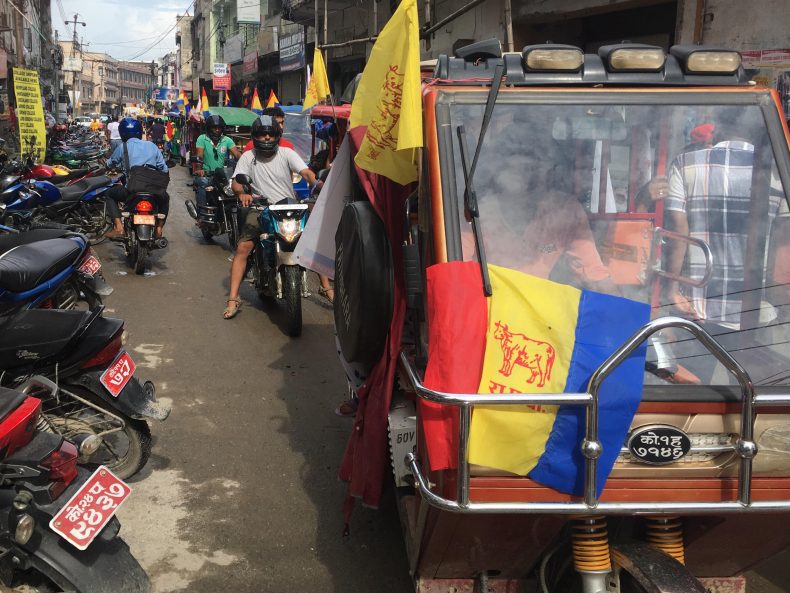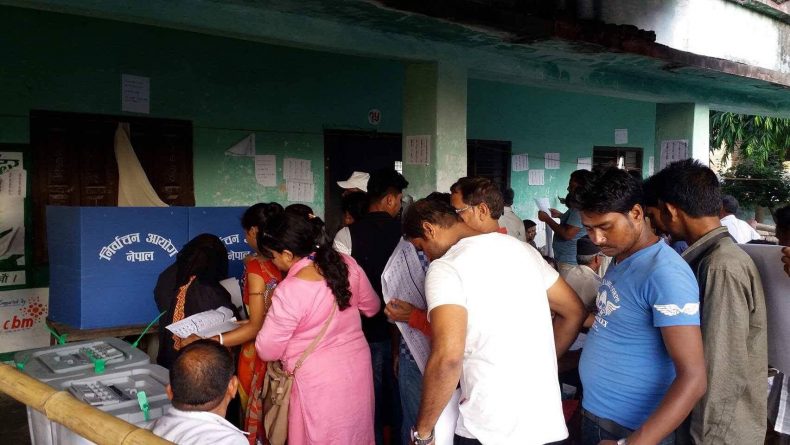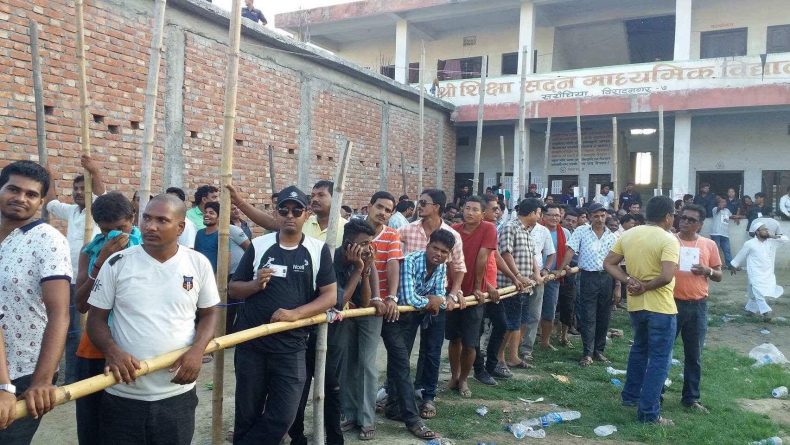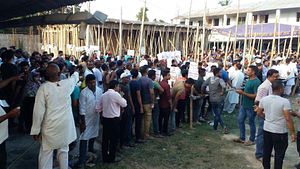BIRATNAGAR, NEPAL — A few days ago, the streets of Biratnagar, Nepal’s fifth-largest city and a commercial hub for the eastern Terai, or plains, were abuzz with the sounds of political campaigns. Electric tuk-tuks plied the streets with outsize gramophone-shaped speakers strapped to their roofs, blasting election jingles, while a crowd gathered outside the city’s central mosque and Hanuman Temple to hear a politician speak above the din of a diesel generator. As a welcome breeze blew through the hot town, party flags with election symbols fluttered: the Nepali Congress’s tree, the Communist Party of Nepal-United Marxist Leninist’s (UML’s) sun, the Communist Party of Nepal-Maoist Center’s hammer and sickle. (Smaller parties and independent candidates, who had the last pick of the draw for pre-approved election symbols, had less-desirable icons: boxing gloves, zebra, motorcycle helmet, dust receptacle).
The elections, which were held June 28 for 334 local government units in three of Nepal’s provinces, represent a significant step forward for the country as it emerges from a decade-long “transition period” and implements its new constitution, promulgated in September 2015. But due to ongoing disagreements over the constitution, some Nepalis are boycotting the election. Others, who are disappointed with the constitution but wish to exercise their democratic rights, head to the polls with reluctance.

Rastriya Prajatantra Party tuk-tuk rally in Biratnagar. Photo by Peter Gill
Sitting inside a tea shop near the city center, Mohammed Firoz, 63, a local tailor, said, “These elections are very important. How can we have development without ward elections?”
Indeed, for many Nepalis, the local elections represent a necessary step toward progress. Since 2002, local governments have been administrated by centrally-appointed bureaucrats, and many initiatives for local development have fallen by the wayside.
In their current campaigns, parties and candidates in Biratnagar have advocated improving infrastructure, sanitation services, pollution control, and creating public parks. The UML’s candidate, Binod Dhakal, has said he will seek to declare Biratnagar the provincial headquarters, while the Federal Socialist Forum Nepal has said it wishes to make Biratnagar a “smart city.” Nepali Congress’s candidate, Bhim Parajuli, has focused on infrastructure development.
Elina Chapagain, a 20-year-old education student who also works as a junior agricultural technician for the government, said she is excited to vote for the first time. She hopes that whoever wins the mayoral seat in Biratnagar will invest more in local roads and agriculture.
Many Biratnagar residents also hope that the elections will end a dearth of accountability.
Firoz, the tailor, says, “Right now the government is run by a secretary. If he wants to come in to work he does. If he doesn’t, he stays home and rests. If people need work done, they can’t get it done.”
In addition, it is expected that having elected officials will control corruption. For some years, the secretaries in charge of local governments implemented government-funded projects in consultation with local “all party mechanisms,” which include local party representatives (albeit unelected ones). Before the all-party mechanisms were disbanded due to widespread corruption, they often colluded to control government resources.
Mahesh Nepal, a governance specialist at the INGO Pact, says, “Now, the chairperson or the mayor will be responsible for all the resources and key decisions held in their respective municipalities. So, we believe that the elected system will be better than the informal engagement of the political parties.”
On a national level, many Nepalis see the local elections – along with provincial and national elections slated for later this year – as a necessary step to emerge from the “transition period” that Nepal entered in 2006, when a Maoist insurgency ended in a peace agreement and the country’s constitutional monarchy was abolished. Since then, the country has seemed to be in perpetual stasis, with two constituent assemblies taking seven years to draft a constitution amid disagreements over its content and control of political power. In April and May 2015, earthquakes rocked the nation, killing nearly 9,000 people and leaving over 750,000 families homeless. Finally, as the country was still reeling from the earthquake, a new constitution was promulgated in September 2015.
In his popular book Lost in Transition, the former senior United Nations official Kul Chandra Gautam expressed the aspirations of many Nepalis when he wrote that after the constitution was promulgated, “one hopes that we can finally put to rest our endless political transition and give primacy to economic development and progress.”

Voters queue for polling in Biratnagar. Photo by Chand Iraki.
Yet this was not to be. The constitution of September 2015 failed to achieve consensus support. Even though it was passed with almost 90 percent approval by the Constituent Assembly, the constitution has engendered significant controversy and protests.
Broadly, the disagreement over the constitution has had to do with the issue of social inclusion, which Nepal has been grappling with ever since the Maoist insurgency began. Nepal is a mixed society of various class, caste, and ethnic groups, which have enjoyed varying degrees of access to power and resources over the centuries. As rebels, the Maoists raised the hopes of many of the poor, low-castes, women, and other marginalized groups by calling for greater inclusion in government and a federal system with provinces delineated on ethnic terms. But as the post-peace constitution-drafting process dragged on, political compromises were made between the Maoists and other mainstream parties that seemed to renege on earlier promises, and as a result new regional or ethnic-based political parties began to emerge. When the constitution was finally promulgated in 2015, organizations representing various ethnic groups, including the Tharu, Limbu, and Madhesis objected to all or parts of it.
Chief among these dissenting voices have been political parties representing Madhesis, a marginalized group from the Terai, or southern plains, who share cultural and linguistic affinities with groups across the border in India. Though they make up roughly 20 percent of Nepal’s population, Madhesis have often been excluded from political leadership in mainstream parties and jobs in the civil service and army.
Madhesi parties have called for the constitution to be amended to create two provinces in the Terai, where the Madhesi population is greatest, and ease the process of citizenship acquisition for children of Nepali mothers and foreign fathers (many Madhesis marry spouses from across the border). The amendment would also reserve jobs in the army and police for marginalized groups, and ensure that the size of constituencies to elect future parliaments will be based on population size rather than geographic size (because the Terai is more densely populated than the hills and mountains, Madhesis stand to lose representatives in parliament if constituencies are delineated based on geography). The Madhesi parties also wish to create more local governments in the Terai, since the region is currently under-represented.
The Madhesi parties have shown willingness to compromise on some of these demands, and the current Congress-Maoist coalition government has voiced support for the amendment. However, the opposition UML, which is the second largest party in Nepal’s legislature, has blocked its passage.
The impasse led to a blockade of the Indian border for four and a half months in 2015-2016. Supplies of essential goods were cut off to Kathmandu and the hills, which were still struggling to recover from the earthquake. The Indian government provided unofficial support to the blockade, but when it pulled this support, the blockade quickly fizzled.
Due to Madhesi parties’ calls for an amendment ahead of elections, the local elections have already been postponed several times. A first stage of elections were held in May in three hill and mountain-based provinces, where opposition to them was minimal. Regarding the second phase of elections in the Terai, the two major Madhesi parties have taken divergent paths. One, the Federal Socialist Forum Nepal, decided to participate in the elections, while still advocating for the amendment. The other, the Rastriya Janata Party (RJPN), put up a boycott, leading the government on June 15 to postpone the elections in Province 2, where Madhesi activism is strongest, until September. (The government also arrested a number of RJPN leaders around the country, though most were later released, and has deployed the army to support police for election security.)
In Biratnagar, Mohammed Nasrul, a young activist for the RJPN, explained his party’s position. “What we’re advocating for is rights. If we’re citizens, why is there discrimination? No one [among mainstream parties] has worried about our demands or fulfilled them.” Nasrul says that he doesn’t think the government will pass the amendment unless they are forced to.

Voters queue for polling in Biratnagar. Photo by Chand Iraki
But in Biratnagar, which is a mixing pot of various ethnic and caste groups, support for the RJPN boycott is not very strong. The town is a prosperous center of trade, and many people fear disruptions to business. Furthermore, Biratnagar has strong support for the Nepali Congress, which traces its roots to the city, where it began as an underground democratic movement in the 1940s. Today, Biratnagar’s mayoral contest is expected to be a close call between two mainstream parties, the Congress and the UML, which also dominated in the first phase of local elections. The Federal Socialist Forum Nepal, whose leader Upendra Yadav is from the neighboring Sunsari District, has put up a mayoral candidate in coalition with the Maoists, and has a number of candidates for other local seats.
Pravin Narayan Chaudhary, 46, an activist for the Maithili language, which is spoken by Madhesis, says he supports the amendment, but will still go to vote. “If we are going to make space for federalism, we need to vote in the election,” he says. “There are unsatisfactory aspects that can be fixed later. Now we need to establish the constitution.”
For many, the decision to vote is not taken lightly. On the one hand, there is a strong desire to move the country out of the “transition” rut it seems to have been stuck on for the past decade and onto the path of development. However, serious objections to the current constitution remain.
On Wednesday evening, the Election Commission announced that polls were conducted largely peacefully around the country, with a 70.5 percent turnout among registered voters. Results from Biratnagar, as well as from other municipalities around the country will emerge in the coming days.
Meanwhile, the issue of the constitutional amendment remains unaddressed, and is likely to reemerge as the country must conduct local elections in Province 2, as well as provincial and national elections before early next year.
Peter Gill is an American journalist based in Nepal. He tweets at @pitaarji

































